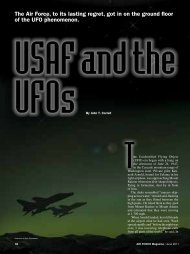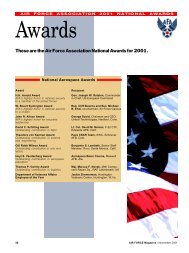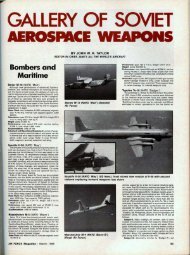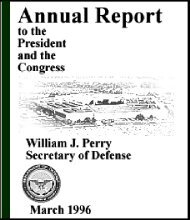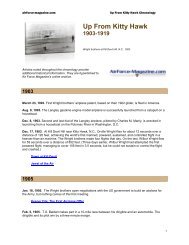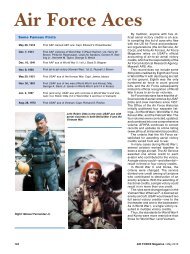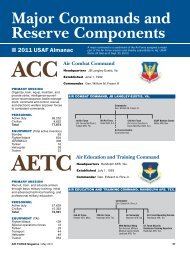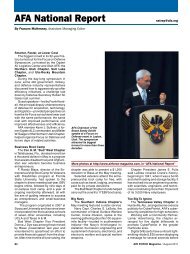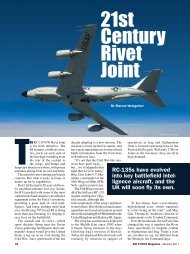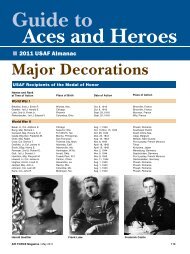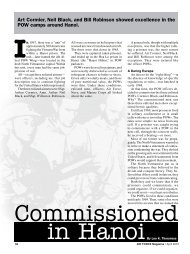1997 Annual Defense Report Table of Contents - Air Force Magazine
1997 Annual Defense Report Table of Contents - Air Force Magazine
1997 Annual Defense Report Table of Contents - Air Force Magazine
Create successful ePaper yourself
Turn your PDF publications into a flip-book with our unique Google optimized e-Paper software.
eadiness, modernization, and infrastructure. This review could produce changes in strategy, resulting<br />
force structure and modernization, and other resource needs.<br />
REGIONAL SECURITY STRATEGIES<br />
The security relationships established by the United States and its allies and friends during the Cold War<br />
are essential to advancing America's post-Cold War agenda. To meet the unique challenges <strong>of</strong> the post-<br />
Cold War era, the United States seeks to further strengthen and adapt these partnerships and to establish<br />
new security relationships in support <strong>of</strong> U.S. interests.<br />
In Europe, the end <strong>of</strong> the Cold War has brought new opportunities and new challenges. Hand in hand with<br />
its North Atlantic Treaty Organization (NATO) allies, the United States has sought to promote a free and<br />
undivided Europe that will work with the United States to keep the peace and promote prosperity. In the<br />
new security architecture <strong>of</strong> an integrated Europe, NATO is the central pillar, complemented by the<br />
Western European Union and a strengthened Organization for Security and Cooperation in Europe. This<br />
is the essential motivation behind U.S. support for NATO enlargement and establishment <strong>of</strong> a strong<br />
NATO-Russia relationship. NATO's Partnership for Peace (PFP) has provided a means for expanding and<br />
intensifying political and military cooperation throughout Europe. NATO members and partners have<br />
participated in many dozens <strong>of</strong> PFP exercises and hundreds <strong>of</strong> other training, planning, and consultation<br />
activities. PFP serves as a pathway for nations to qualify for NATO membership; for those partners that<br />
do not choose to join NATO, PFP provides an enduring framework for their relations with NATO and<br />
constitutes concrete pro<strong>of</strong> that the alliance is concerned about their security. Partnership for Peace<br />
bolsters efforts by Central and Eastern European nations and the New Independent States to build<br />
democratic societies and strengthen regional stability. Other efforts, including the European Command's<br />
Joint Contact Team Program and Marshall Center, similarly advance U.S. defense engagement with<br />
Central and Eastern Europe and the New Independent States.<br />
Secretary Perry made building cooperative defense and military ties with Russia, Ukraine, and the other<br />
New Independent States one <strong>of</strong> the Department <strong>of</strong> <strong>Defense</strong>'s highest priorities. Moving away from the<br />
hostility <strong>of</strong> the Cold War and reducing its lethal nuclear legacy will be neither instantaneous nor easy.<br />
Steady, continued engagement that focuses on mutual security interests is the cornerstone in building<br />
constructive relationships with the New Independent States. Through the pursuit <strong>of</strong> a pragmatic<br />
partnership, the United States is striving to manage differences with Russia to ensure that shared security<br />
interests and objectives take priority. A central objective is to encourage Russia to play a constructive role<br />
in the new European security architecture through the development <strong>of</strong> NATO-Russia relations and<br />
through Russia's active participation in PFP.<br />
The East Asian-Pacific region continues to grow in importance to U.S. security and prosperity. This<br />
region has experienced unprecedented economic growth in the past decade and is projected to have the<br />
highest rate <strong>of</strong> economic growth in the world over the next 25 years. The security and stability provided<br />
by the presence <strong>of</strong> U.S. military forces in the East Asian-Pacific region over the past 40 years created the<br />
conditions and potential for such tremendous growth. Security, open markets, and democracy, the three<br />
strands <strong>of</strong> the President's National Security Strategy, are thoroughly intertwined in this region.<br />
Today, the United States retains its central role as a force for stability in East Asia-Pacific, but it has<br />
begun to share greater responsibility for regional security with its friends and allies. The United States<br />
constructively participates in and supports regional security dialogues. It actively encourages efforts by<br />
East Asian-Pacific nations to provide host-nation support for U.S. forces, contribute to United Nations<br />
(UN) peace operations, and participate in international assistance efforts throughout the world. While<br />
these regional initiatives are important, there is no substitute for a forward-stationed U.S. military<br />
7


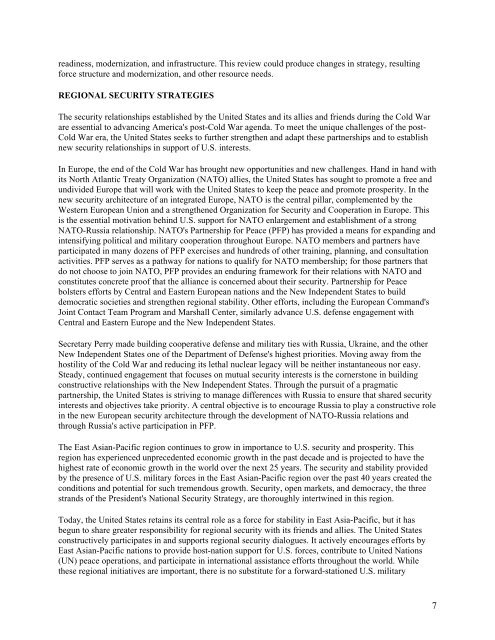
![[PDF] Foulois - Air Force Magazine](https://img.yumpu.com/13391007/1/190x253/pdf-foulois-air-force-magazine.jpg?quality=85)
